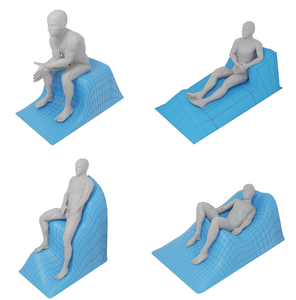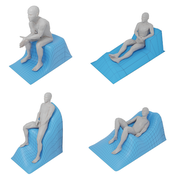Information
- Publication Type: Journal Paper (without talk)
- Workgroup(s)/Project(s):
- Date: April 2020
- Journal: Computer Aided Geometric Design
- Open Access: yes
- Volume: 79
- Date (from): 1. January 2020
- Date (to): 1. January 2020
- Event: Conference
- Pages: 1 – 1
- Keywords: pose estimation, furniture, computational design
Abstract
The design of functional seating furniture is a complicated process which often requires extensive manual design effort and empirical evaluation. We propose a computational design framework for pose-driven automated generation of body-supports which are optimized for comfort of sitting. Given a human body in a specified pose as input, our method computes an approximate pressure distribution that also takes frictional forces and body torques into consideration which serves as an objective measure of comfort. Utilizing this information to find out where the body needs to be supported in order to maintain comfort of sitting, our algorithm can create a supporting mesh suited for a person in that specific pose. This is done in an automated fitting process, using a template model capable of supporting a large variety of sitting poses. The results can be used directly or can be considered as a starting point for further interactive design.Additional Files and Images
Weblinks
BibTeX
@article{leimer_2020-cag,
title = "Pose to Seat: Automated design of body-supporting surfaces",
author = "Kurt Leimer and Andreas Winkler and Stefan Ohrhallinger and
Przemyslaw Musialski",
year = "2020",
abstract = "The design of functional seating furniture is a complicated
process which often requires extensive manual design effort
and empirical evaluation. We propose a computational design
framework for pose-driven automated generation of
body-supports which are optimized for comfort of sitting.
Given a human body in a specified pose as input, our method
computes an approximate pressure distribution that also
takes frictional forces and body torques into consideration
which serves as an objective measure of comfort. Utilizing
this information to find out where the body needs to be
supported in order to maintain comfort of sitting, our
algorithm can create a supporting mesh suited for a person
in that specific pose. This is done in an automated fitting
process, using a template model capable of supporting a
large variety of sitting poses. The results can be used
directly or can be considered as a starting point for
further interactive design.",
month = apr,
journal = "Computer Aided Geometric Design",
volume = "79",
event = "Conference",
pages = "1--1",
keywords = "pose estimation, furniture, computational design",
URL = "https://www.cg.tuwien.ac.at/research/publications/2020/leimer_2020-cag/",
}


 image
image Paper
Paper
